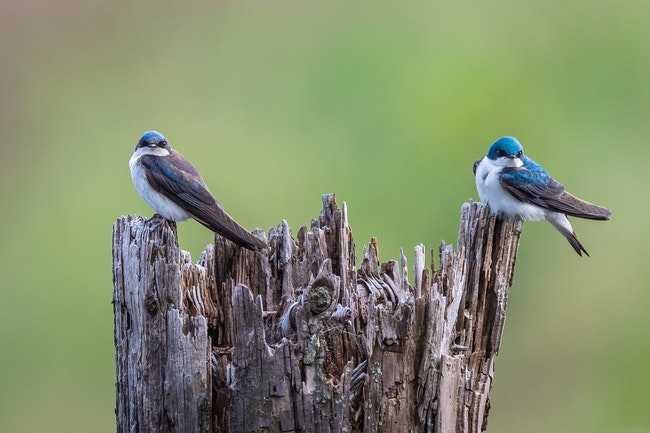 Tree swallows (Courtesy/Albert Ryckman)
Tree swallows (Courtesy/Albert Ryckman)
It is the time of year for the semi-annual bird migration in the Northern Hemisphere. Billions of birds from hundreds of species leave their breeding habitat to winter elsewhere. Most head to warmer climates. That often means swimming or flying south toward the tropics. But it may mean moving to milder coastal areas or dropping to a much lower elevation. Birds that leave in late summer or fall will return sometime next year if they survive, before breeding season.
Here in the Willamette Valley, about half of our breeding species migrate out. At the same time, we get an influx of birds from the north and northeast as well as some montane species seeking ground that is not snow-covered. Few species remain at 8,000 feet in snow-covered mountains.
Most departing migrants are insectivores or larger predators—swallows, flycatchers, swifts, Osprey, many warblers and vireos. Some migration patterns are showing change due to global warming. More turkey vultures remain here now than previously.
Birds that may arrive here from the mountains include golden-crowned and fox sparrows, hermit and varied thrush, yellow-rumped warblers, siskins, and many more juncos. Most obviously we get grazing flocks of cackling geese from Canada and Alaska. They crowd our wildlife refuges until spring. We get many wintering ducks including shoveler, wigeon and bufflehead. Other wintering birds include loons, sandhill cranes on Sauvie Island, additional large hawks, short-eared owls, merlin, visiting flickers and robins.
Studying migration has led to amazing discoveries. Navigation is key. Some birds can hear the low rumble of ocean waves from 300 miles inland so they parallel the distant coast. Most small birds migrate at night. They use stars to navigate, but on dark nights they have special chemicals in cells inside the eye that “see” the magnetic waves of the earth. Many birds can smell water. Birds have precise visual memories of landscape and land marks. Some move in flocks, some as loners.
Tiny ruby-throated hummingbirds fly non-stop across the Gulf of Mexico, twice. Oregon’s smallest bird, the Calliope Hummingbird, flies back and forth to Central America. Bar-tailed godwits have flown non-stop from Alaska to New Zealand—9,000 miles. Arctic terns migrate between the two poles—over 18,000 mile round trip. Sooty shearwaters fly a 40,000 mile round-trip, on a figure-eight path, from breeding sites in the Southern Hemisphere to better fishing off the Oregon and California coasts.
Migration is inevitably fatal for some individuals. People make migration more dangerous than it once was. Outdoor housecats and building collisions are the worst known killers. American Bird Conservatory has done a lot of research to help us build better for birds.
For information about upcoming Salem Audubon programs and activities, see www.salemsudubon.org, or Salem Audubon’s Facebook page.
Harry Fuller is an Oregon birder and natural history author of “Freeway Birding.” He is a member of the Salem Audubon Society. Contact him at [email protected] or http://www.towhee.net/. His “Some Fascinating Things About Birds” column will be appearing regularly in Salem Reporter.
JUST THE FACTS, FOR SALEM – We report on your community with care and depth, fairness and accuracy. Get local news that matters to you. Subscribe to Salem Reporter starting at $5 a month. Click I want to subscribe!









